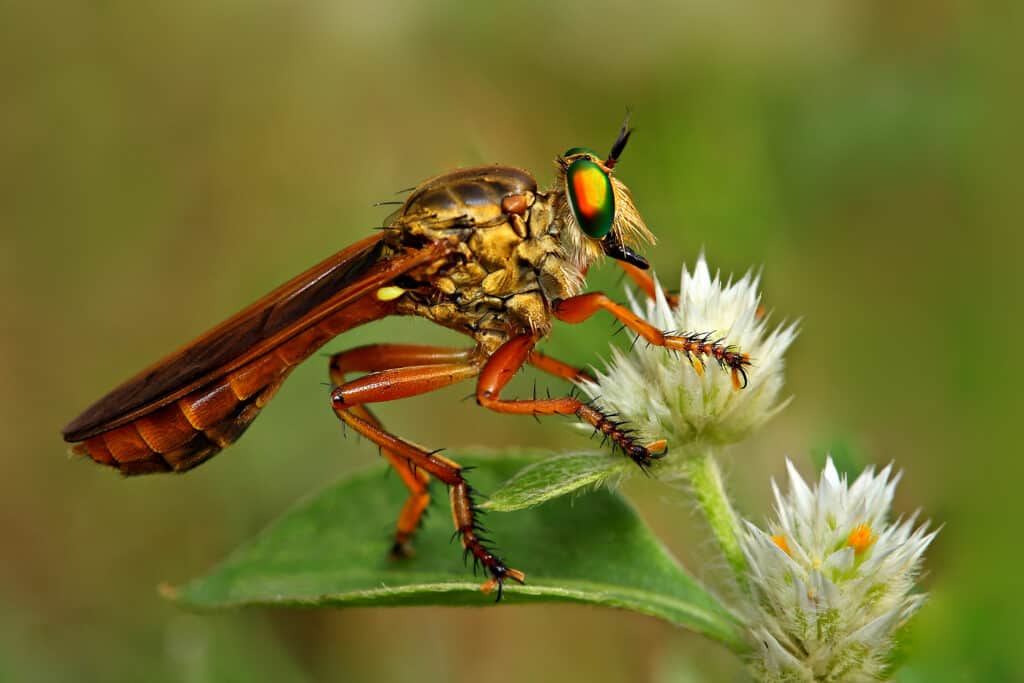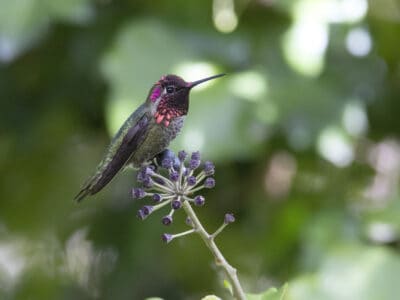Robber Flies
Asilidae
The female pretend they are dead if they do not find the male worthy of mating.
Advertisement
Robber Flies Scientific Classification
Read our Complete Guide to Classification of Animals.
Robber Flies Conservation Status
Robber Flies Facts
- Prey
- Insects and birds
- Name Of Young
- Larvae
- Group Behavior
- Group
- Fun Fact
- The female pretend they are dead if they do not find the male worthy of mating.
- Most Distinctive Feature
- Pointy head and long, hairy legs
- Other Name(s)
- Assassin Flies
- Habitat
- Open and airy spaces
- Predators
- Lizards, Birds, Frogs
- Diet
- Carnivore
- Lifestyle
- Group
- Favorite Food
- beetles, grasshoppers, butterflies, bees, wasps, and even hummingbirds.
- Common Name
- Robber Flies
- Number Of Species
- 6998
- Location
- Worldwide except Antarctica
View all of the Robber Flies images!
Summary
Robber Flies are flies that are known for their aggressive predator habits and can attack their prey mid-flight. They are found in abundance across the world and belong to a diverse insect family. Robber flies get their name because of their hostile behavior while attacking prey. They hide on their perches and suddenly attack prey by pouncing on them as soon as they get the chance. They also imitate bees or wasps to prey on other insects.
Robber Flies Species, Types, and Scientific name
The Robber Flies belong to the family Asilidae and are of the order Diptera. They belong to the broad group of species that pounce on their prey mid-air. People often refer to these flies as assassin flies because of their predatory behavior.
They are sometimes mistaken for biting flies or horseflies, but this is a misconception. Robber Flies may be aggressive to their prey, but they do not drink blood and they are not predators of humans. However, if you provoke them, they might bite in self-defense.
Robber flies are spread around the whole world and include more than 7000 species. Of this number, 1000 are only found in North America. This species is still being observed and new facts are being discovered even today. The currently accepted sub-families are as follows:
- Asilinae
- Bathypogoninae
- Brachyrhopalinae
- Dasypogoninae
- Dioctriinae
- Laphriinae
- Leptogastrinae
- Ommatiinae
- Phellinae
- Stenopogoninae
- Stichopogoninae
- Tillobromatinae
- Trigonomiminae
- Willistonininae
Appearance: How To Identify Robber Flies

Robber flies are aggressive and predatory. Those qualities are why they’ll also often be referred to as Assassin Flies.
©Seema Swami/Shutterstock.com
Eggs
The female Robber Flies lay their whitish eggs on low-lying grasses or in the crevices of bark or soil. The nest depends on the type of abdomen that the female possesses. Depending on its morphology, the female may lay the eggs away from the nest, within the soil, or in cavities of plant cells. Amounts of eggs laid are unknown.
The eggs carry micro sculptures that are only visible under observation through a microscope. They are typically either oval or spherical but are always almost 0.07 inches long.
Larva
The eggs hatch into a larva that is white or yellowish. The larva is predatory and may feed on eggs, other larvae, and small insects to survive. They migrate in the winter to pupate under the soil and emerge as grown adults. The total time for a larva to become an adult takes one to three years but their growth as larvae is accelerated in the warmer regions.
Adult
The Robber Flies measure up to 0.39 to 0.59 inches in length, making them the largest of all flies. Many Robber Flies are long and slender, with tapered abdomens similar to damsel flies. Some of the species are short and stout, resembling bumblebees.
The Robber Flies have beak-like heads that are pointed and stiff. This pointy head serves as a weapon. It is first used as a dagger to kill, then as a needle to inject the poison for killing the prey, and finally as a straw to gobble up the broken-down food. They have hairy bodies and their mouth parts are also covered in a tuft of hair.
Most of the Robber Flies are black or brown. Sexual dimorphism is also quite visible but not to an extreme extent. The females have a broader abdomen to carry eggs after mating.
Another interesting characteristic is their eyes. One compound eye is present on either side of its head and can see two different fields of view. This allows Robber Flies to observe a different stimuli at the same time.
The Robber Flies have short and hairy antennae and long and slender legs. Their six legs have fleshy pads on their ends and are great for holding down prey. You can typically spot 6 to 8 hairy segments on their bodies but sometimes the last segments are obscured. Robber Flies have only one pair of wings.
Behavior
The behavior of the Robber Flies is both aggressive and predatory. They can eat any flying insect they see, which may be the reason why their population can be large in a very small area.
Their mating behavior is quite effective. A female judges their partner and observes whether the male fellow is worthy. If they do not find the male to be a good mate, they pretend they are dead. Finding the female unresponsive, the male drops the female and flies away in search of another.
Habitat: Where to find Robber Flies
The Robber Flies have a cosmopolitan distribution. This means that they are either found all over the world or in most parts of the globe. There are over 7000 species of this particular insect currently discovered world-wide, however, they are not found in Antarctica.
Their population rate is quite high. They can spread quickly and are often found in huge numbers in small areas. This is likely due to their eating habits which suggest they can eat up to 1 to 2% of the flying insects in the region they have inhabited.
More specifically, you can spot them in open areas so they can fly to hunt and then grasp their prey. Any open areas like grasslands, fields, ponds and streams, marshes, and crevices in woody areas are some examples. They usually have a perched area that allows them to give space to eat their prey safely after hunting.
Diet: What do Robber Flies Eat?
The Robber Flies are aggressive eaters and predators. They can sight their prey from afar and grasp them in mid-air for a fulfilling meal. They have a needle-like head that injects venom to subdue the prey. This venom has an enzyme that can break down the body of the victim, allowing Robber Flies to digest their food easily.
What Does Robber Fly Eat?
Their larvae eat other’s eggs, larvae, and even small insects. As for the adults, they can eat any flying insect in sight. These include beetles, grasshoppers, butterflies, bees, wasps, and even hummingbirds.
How Much Do Robber Flies Eat?
They can easily consume one to two prey a day.
What Eats Robber Flies?
Their predators include lizards, birds, bats, large spiders, frogs, etc.
Prevention: How to get rid of Robber Flies
The Robber Flies are not dangerous to people. They do not attack humans and are beneficial to the environment as they can help reduce pest populations. However, it is better to be careful around them because if provoked or mishandled, they might bite.
Up Next…
Check out some of our other insect articles.
- Top 10 Insects In The World – Discover the biggest insects in the world!
- 15 Animals That Eat Insects – Find out what animals can help you get rid of pests.
- Mega Bugs – Read about the largest bugs to ever exist.
Robber Flies FAQs (Frequently Asked Questions)
Are Robber Flies dangerous?
They are dangerous predators but are not harmful to a human. They may, however, attack if not treated right.
How many legs does the Robber Fly have?
It has 3 pairs of legs.
Why are they called Robber Flies?
Because of their aggressive predatory behavior. They attack prey by hiding on their perches and pouncing on them as soon as they get the chance.
How do you identify the Robber Flies?
They have one pair of wings, a hairy body with long legs, and a pointy head that is covered with hair too.
Thank you for reading! Have some feedback for us? Contact the AZ Animals editorial team.
Sources
- MDC, Available here: https://mdc.mo.gov/discover-nature/field-guide/robber-flies
- Colorado Arts and Science Magazine, Available here: https://www.colorado.edu/asmagazine/2020/02/28/robber-flies-are-fierce-predators-and-resourceful-lovers
- UFL, Available here: https://entnemdept.ufl.edu/creatures/beneficial/flies/robber_flies.htm
- Wikipedia, Available here: https://en.wikipedia.org/wiki/Asilidae
- Wisconsin Horticulture, Available here: https://hort.extension.wisc.edu/articles/robber-flies-asilidae/
- Britannica, Available here: https://www.britannica.com/animal/robber-fly
- Australian Museum, Available here: https://australian.museum/learn/animals/insects/robber-flies/
- NCSU, Available here: https://entomology.ces.ncsu.edu/biological-control-information-center/beneficial-predators/robber-fly/
- Aggie Horticulture, Available here: https://aggie-horticulture.tamu.edu/galveston/beneficials/beneficial-27_robber_flies.htm
- Your Conroe News, Available here: https://www.yourconroenews.com/neighborhood/moco/sports/article/Robber-flies-function-as-both-predator-and-prey-9249402.php

















